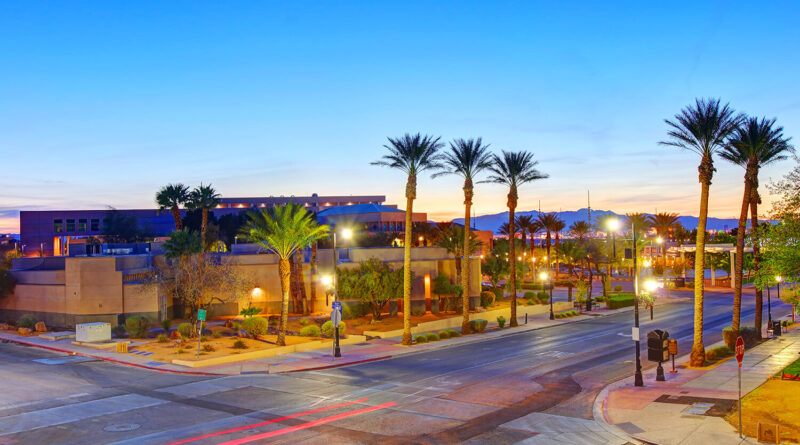History of Henderson Nevada
Henderson, Nevada, is a city that has grown from a modest wartime industrial base to become one of the most significant suburban communities in the United States. Located just southeast of Las Vegas, Henderson offers a unique blend of historical significance, economic development, and cultural growth. Understanding the history of Henderson provides insight into its transformation from a vital industrial center during World War II to a thriving city known for its quality of life, vibrant economy, and community-oriented living.
2. Prehistoric and Indigenous History
Before Henderson became the bustling city it is today, the area was home to ancient peoples who lived in the Las Vegas Valley. Archaeological evidence suggests that prehistoric communities, including the Ancestral Puebloans, inhabited the region for thousands of years. These early inhabitants adapted to the harsh desert environment, developing sophisticated agricultural practices and creating intricate networks of trade with neighboring tribes.
The Native American tribes, particularly the Southern Paiutes, played a significant role in the history of the area. The Paiutes lived in the region for centuries, developing a deep connection to the land. They were skilled hunters and gatherers, utilizing the resources of the desert to sustain their communities. The cultural influence of these indigenous peoples can still be felt in the area, with their traditions and history preserved in local museums and cultural centers.
3. Early European Exploration
The arrival of European explorers in the Southwest marked a new chapter in the history of Henderson. In the late 18th century, Spanish explorers ventured into the region, mapping the area and establishing trade routes. These early explorers, including the famous Francisco Garcés, were among the first Europeans to encounter the indigenous populations of Southern Nevada.
The impact of European settlement in the area was gradual but profound. Over time, the introduction of new technologies, agricultural practices, and trade goods began to change the way of life for the Native American tribes. While Henderson itself was not directly settled by Europeans during this period, the broader influence of European exploration set the stage for the later development of the Las Vegas Valley.
4. Formation of the Las Vegas Valley
The Las Vegas Valley, where Henderson is located, has a unique geographical and environmental profile that has significantly influenced its development. The valley is characterized by its arid desert climate, with hot summers and mild winters, which has shaped the way people have lived and worked in the area for centuries.
Early settlers were drawn to the Las Vegas Valley due to its strategic location along key trade routes and its access to water from the Colorado River. These factors made the valley an attractive place for ranching and farming, despite the challenges posed by the desert environment. By the late 19th century, small communities had begun to take root in the valley, laying the foundation for the future growth of cities like Henderson and Las Vegas.
5. The Birth of Henderson
The official birth of Henderson as a city is closely tied to World War II and the U.S. government’s efforts to support the war effort. In 1941, the U.S. War Department identified the need for magnesium, a critical material used in the production of aircraft and munitions. To meet this demand, the Basic Magnesium Plant (BMP) was established in the Las Vegas Valley, on the site that would later become Henderson.
The BMP was a massive industrial complex that employed thousands of workers, many of whom relocated to the area specifically for the job opportunities it offered. The plant was one of the largest of its kind in the world, producing vast quantities of magnesium that were essential to the Allied war effort. As the plant grew, so did the surrounding community, with the government constructing housing, schools, and other infrastructure to support the workers and their families.
6. Post-War Expansion and Incorporation
With the end of World War II, the need for magnesium decreased, and the future of Henderson was uncertain. However, the city’s leaders and residents were determined to ensure that Henderson did not become a ghost town. Efforts were made to attract new industries and diversify the local economy. The successful transition from a wartime industrial center to a peacetime community laid the groundwork for Henderson’s future growth.
In 1953, Henderson was officially incorporated as a city, marking a significant milestone in its history. The incorporation allowed the city to establish its own government and begin planning for future development. This period saw the expansion of residential areas, the establishment of local businesses, and the creation of public services that would support the city’s growing population.
7. Economic Development and Industrial Growth
Following its incorporation, Henderson experienced steady economic growth, driven by a combination of industrial development and the expansion of the Las Vegas metropolitan area. The city’s early economy was still heavily influenced by manufacturing, with industries such as chemicals, textiles, and electronics playing a key role in providing jobs and supporting the local economy.
Over the decades, Henderson diversified its economic base, attracting new industries such as technology, healthcare, and retail. The city’s proximity to Las Vegas and its strategic location along major transportation routes made it an attractive place for businesses to set up operations. This diversification helped Henderson weather economic downturns and contributed to its reputation as a stable and prosperous community.
8. Residential and Urban Development
As Henderson’s economy grew, so did its population, leading to significant residential and urban development. The city saw the construction of numerous housing developments, ranging from modest single-family homes to large, master-planned communities. One of the most notable developments was Green Valley, a large master-planned community that became a model for suburban living in the region.
The growth of these communities was accompanied by the expansion of infrastructure, including roads, schools, parks, and public services. Henderson’s commitment to careful planning and quality of life made it a desirable place to live, attracting residents from across the United States. The city’s emphasis on creating a balanced and sustainable community has been a key factor in its long-term success.
9. The Role of Henderson in Southern Nevada
Henderson’s role within the broader context of Southern Nevada is significant. As one of the largest cities in the state, Henderson has played a vital role in the economic and social development of the region. The city’s relationship with Las Vegas, its more famous neighbor, has been one of both cooperation and competition.
While Las Vegas is known for its tourism and entertainment industries, Henderson has carved out a niche as a residential and commercial hub. The city’s focus on quality of life, education, and economic diversification has complemented Las Vegas’s offerings, making Southern Nevada a more well-rounded and attractive region for both residents and businesses.
10. Henderson’s Education and Cultural Development
Education and culture have been central to Henderson’s development. The city is home to a variety of educational institutions, including public and private schools, as well as higher education facilities like Nevada State College and Touro University. These institutions have contributed to the city’s reputation as a center for learning and innovation.
Culturally, Henderson has developed a rich array of amenities, including theaters, museums, galleries, and parks. The city’s commitment to cultural enrichment is evident in its support for the arts and its investment in recreational facilities. Events such as the annual Shakespeare in the Park and the Henderson Heritage Parade and Festival highlight the city’s dedication to celebrating its history and fostering community engagement.
11. Henderson in the Late 20th Century
The late 20th century was a period of significant growth and change for Henderson. During the 1980s and 1990s, the city experienced a population boom as people moved to the area for its affordable housing, good schools, and proximity to Las Vegas. This growth presented both opportunities and challenges, as the city worked to keep pace with the increasing demand for services and infrastructure.
Henderson’s leaders focused on managing this growth through careful planning and investment in public facilities. The city’s emphasis on sustainability and environmental stewardship became increasingly important as it sought to balance development with the preservation of natural resources. This period also saw the expansion of Henderson’s parks and recreational areas, which have become a hallmark of the city’s commitment to quality of life.
12. Henderson in the 21st Century
In the 21st century, Henderson has continued to evolve, becoming one of the fastest-growing cities in the United States. The city’s population has more than doubled since the year 2000, and it has become a major center for both business and residential development. Henderson’s economy has diversified further, with significant growth in sectors such as technology, healthcare, and education.
The city’s leaders have focused on creating a sustainable and resilient community, with initiatives aimed at reducing environmental impact and promoting renewable energy. Henderson has also invested in its infrastructure, with new roads, public transportation options, and community facilities being developed to meet the needs of its growing population. Today, Henderson is known for its high quality of life, excellent schools, and vibrant economy, making it one of the most desirable places to live in Nevada.
13. Environmental and Sustainability Efforts
Henderson’s commitment to environmental sustainability has become increasingly important in recent years. The city has implemented a range of initiatives aimed at reducing its carbon footprint, conserving water, and promoting green building practices. These efforts are part of a broader strategy to ensure that Henderson remains a livable and attractive community for future generations.
One of the key challenges facing Henderson is water conservation, given the region’s arid climate and reliance on the Colorado River. The city has implemented a variety of measures to reduce water use, including incentives for residents to replace lawns with drought-resistant landscaping and the promotion of water-efficient appliances. Henderson has also invested in renewable energy projects, such as solar power, to reduce its dependence on fossil fuels.
14. Henderson Today: A Modern City
Today, Henderson stands as a modern city with a rich history and a bright future. With a population of over 330,000, it is the second-largest city in Nevada and a major economic and cultural hub in Southern Nevada. The city’s economy is diverse, with key industries including manufacturing, healthcare, education, and technology.
Henderson is also known for its high quality of life, with excellent schools, abundant parks, and a wide range of cultural and recreational amenities. The city’s commitment to sustainability and smart growth has made it a model for other communities in the region. As Henderson continues to grow, it remains focused on maintaining the balance between development and the preservation of its unique desert environment.
15. Future Prospects and Vision for Henderson
Looking to the future, Henderson faces both opportunities and challenges. The city’s leaders are focused on continuing to diversify the economy, attract new businesses, and ensure that Henderson remains a great place to live and work. Planned developments, including new residential areas, commercial centers, and infrastructure projects, will play a key role in shaping the city’s future.
Henderson’s vision for the future is one of continued growth, sustainability, and innovation. The city aims to be a leader in environmental stewardship, economic development, and community engagement. With its strong foundation and forward-looking approach, Henderson is well-positioned to continue thriving in the years to come.
16. Conclusion
Henderson, Nevada, has come a long way from its beginnings as a wartime industrial center. Today, it is a vibrant, modern city with a rich history and a bright future. The city’s journey from its origins in the Basic Magnesium Plant to its current status as a thriving suburban community is a testament to the resilience and vision of its residents and leaders. Henderson’s history is not just a story of growth and development; it is a story of a community that has worked together to create a place where people can live, work, and thrive.
17. FAQs
1. Why was Henderson originally established?
Henderson was established during World War II to support the war effort by producing magnesium, a critical material for aircraft and munitions. The Basic Magnesium Plant was built to meet this demand, and the surrounding community grew rapidly as workers and their families moved to the area.
2. What industries have been most important to Henderson’s growth?
Initially, Henderson’s growth was driven by manufacturing, particularly during World War II. Over time, the city diversified its economy to include technology, healthcare, and education, which have become key industries in the city’s continued development.
3. How has Henderson’s relationship with Las Vegas evolved?
Henderson’s relationship with Las Vegas has evolved from being a bedroom community to becoming a significant economic and cultural hub in its own right. While Las Vegas is known for tourism and entertainment, Henderson has focused on residential development, education, and economic diversification.
4. What are some key cultural and educational institutions in Henderson?
Henderson is home to several important cultural and educational institutions, including Nevada State College, Touro University, and the Henderson Pavilion. The city also hosts numerous cultural events, such as Shakespeare in the Park and the Henderson Heritage Parade and Festival.
5. How has Henderson addressed environmental and sustainability concerns?
Henderson has implemented a range of sustainability initiatives, including water conservation programs, renewable energy projects, and green building practices. The city is focused on reducing its environmental impact and ensuring that it remains a livable community for future generations.
6. What does the future hold for Henderson?
The future of Henderson looks bright, with continued growth and development on the horizon. The city plans to focus on economic diversification, sustainability, and community engagement to ensure that it remains a desirable place to live and work.
Discover more from City Towner
Subscribe to get the latest posts sent to your email.




